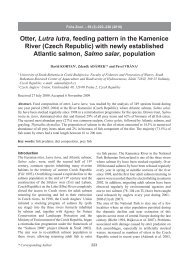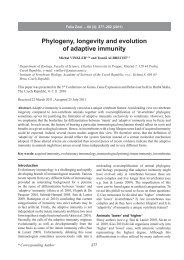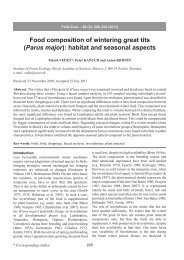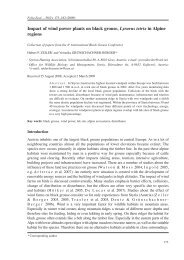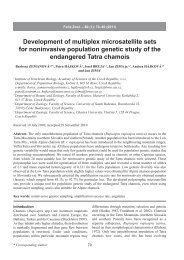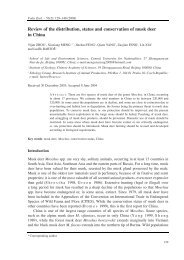Factors affecting the nest site selection of the black stork, Ciconia ...
Factors affecting the nest site selection of the black stork, Ciconia ...
Factors affecting the nest site selection of the black stork, Ciconia ...
Create successful ePaper yourself
Turn your PDF publications into a flip-book with our unique Google optimized e-Paper software.
Folia Zool. – 57(3): 251–257 (2008)<br />
<strong>Factors</strong> <strong>affecting</strong> <strong>the</strong> <strong>nest</strong> <strong>site</strong> <strong>selection</strong> <strong>of</strong> <strong>the</strong> <strong>black</strong> <strong>stork</strong>, <strong>Ciconia</strong><br />
nigra in <strong>the</strong> Dadia-Lefkimi-Soufli National Park, north-eastern Greece<br />
Christos G. VLACHOS 1 *, Dimitrios E. BAKALOUDIS 2 , Olga G. ALEXANDROU 1 ,<br />
Vasileios A. BONTZORLOS 3 and Malamati A. PAPAKOSTA 1<br />
1 Department <strong>of</strong> Forestry and Natural Environment, Aristotle University <strong>of</strong> Thessaloniki, P.O. Box 241, 540 06<br />
Thessaloniki, Greece; *e-mail: cvlachos@for.auth.gr<br />
2 Forestry Service, Section <strong>of</strong> Forest Management and Protection, 6 Ermou Str., 684 00 Soufli, Greece<br />
3 Department <strong>of</strong> Animal Biology-Zoology, Faculty <strong>of</strong> Biology, University <strong>of</strong> Salamanca, 37071 Salamanca,<br />
Spain<br />
Received 13 February 2007; Accepted 11 December 2007<br />
* Corresponding author<br />
A b s t r a c t . Nest <strong>site</strong> preference <strong>of</strong> <strong>black</strong> <strong>stork</strong> <strong>nest</strong>ing in <strong>the</strong> Dadia-Lefkimi-Soufli National<br />
Park, nor<strong>the</strong>astern Greece was studied through <strong>the</strong> 2003 - 2004 field seasons. Seventeen <strong>nest</strong>trees<br />
and <strong>the</strong>ir surroundings (0.1 ha circular plot centered at <strong>nest</strong>-tree) were described<br />
and compared to <strong>the</strong> characteristics <strong>of</strong> <strong>the</strong> same number <strong>of</strong> paired, randomly selected<br />
plots. Black <strong>stork</strong>s usually <strong>nest</strong>ed in old pines, on branches at a mean distance 1.5 m<br />
from <strong>the</strong> trunk or against <strong>the</strong> trunk. Nest <strong>site</strong>s were located at slopes significantly steeper<br />
and significantly closer to small streams compared to random plots. The total tree<br />
density at <strong>nest</strong> <strong>site</strong>s was significantly lower and <strong>the</strong> mean canopy closure immediately<br />
adjacent to <strong>black</strong> <strong>stork</strong> <strong>nest</strong> trees was also significantly lower compared to that adjacent<br />
to <strong>the</strong> randomly selected trees. Nest <strong>site</strong>s had lower tree basal area than randomly<br />
selected <strong>site</strong>s, suggesting that <strong>the</strong> less wood volume <strong>site</strong>s were preferred for <strong>nest</strong>ing by<br />
<strong>black</strong> <strong>stork</strong>s in <strong>the</strong> study area.<br />
Key words: <strong>nest</strong>ing habitat, <strong>nest</strong> tree, forest structure, logging activities, NE Greece<br />
Introduction<br />
The <strong>black</strong> <strong>stork</strong>, <strong>Ciconia</strong> nigra is a ra<strong>the</strong>r shy, solitary species, vulnerable to human<br />
disturbances and avoids its habitation (Kahl 1987). In contrary to <strong>the</strong> white <strong>stork</strong>, <strong>Ciconia</strong><br />
ciconia which is found mainly in human habitations, <strong>the</strong> <strong>black</strong> <strong>stork</strong> is a forest dwelling<br />
species and it inhabits old undisturbed forest areas, interspersed with shallow lakes, marshes<br />
and ponds as well as streams (Mériaux et al. 1991).<br />
The <strong>black</strong> <strong>stork</strong> has an extensive breeding range – from Europe to nor<strong>the</strong>astern China<br />
and also breeds in sou<strong>the</strong>rn Africa. The European population has suffered considerable<br />
decrease throughout its range, particularly in west Europe along <strong>the</strong> 20th century (Cramp<br />
& S immons 1977, Del Hoyo et al. 1992) but <strong>the</strong> whole population remained stable<br />
recently and <strong>the</strong> species is currently evaluated as Least Concern in <strong>the</strong> IUCN Red List <strong>of</strong><br />
Threatened Species (Birdlife International 2000, IUCN 2004). Destruction <strong>of</strong> forests and<br />
particularly <strong>the</strong> limitation <strong>of</strong> large <strong>nest</strong>ing trees have been reported as <strong>the</strong> main threats<br />
for <strong>black</strong> <strong>stork</strong> population decline (L õhmus & S ellis 2003, R osenvald &<br />
Lõhmus 2003). In addition, foraging habitat degradation and especially <strong>the</strong> drainage<br />
<strong>of</strong> permanent water courses (L õhmus & S ellis 2001), <strong>the</strong> loss <strong>of</strong> wetlands and <strong>the</strong><br />
use <strong>of</strong> pesticides in wintering grounds in Africa have contributed to <strong>the</strong> population decline<br />
(H ancock et al. 1992).<br />
251
The <strong>black</strong> <strong>stork</strong> population has also declined in Greece, and it is listed as an endangered<br />
species in <strong>the</strong> Red Data Book <strong>of</strong> threatened vertebrates (K arandinos 1992). The<br />
reasons for <strong>the</strong> species decline have not been yet firmly established and it is possible that<br />
several causes are involved. Land use changes due to new agricultural practices, intensive<br />
exploitation <strong>of</strong> <strong>the</strong> forests, alteration <strong>of</strong> wetland habitats and <strong>the</strong> drainage <strong>of</strong> small ponds<br />
and marshes have been recognized <strong>the</strong> factors reducing <strong>the</strong> population <strong>of</strong> <strong>black</strong> <strong>stork</strong> in<br />
Greece. The province <strong>of</strong> Evros is <strong>the</strong> most important breeding area for <strong>the</strong> species in Greece.<br />
It has been estimated that more than 30 pairs breed in <strong>the</strong> area (pers. observations) while<br />
in <strong>the</strong> whole country <strong>the</strong> total breeding population is approximately 30-50 pairs (BirdLife<br />
International 2004).<br />
The present study was carried out in <strong>the</strong> Dadia-Lefkimi-Soufli National Park (<strong>the</strong>reafter<br />
D-L-S NP) during <strong>the</strong> 2003-2004 field seasons to determine <strong>the</strong> species <strong>nest</strong>ing habitat<br />
requirements, in order to provide useful management implications to forest managers for <strong>the</strong><br />
increasing <strong>the</strong> breeding habitat availability in <strong>the</strong> region.<br />
Study Area<br />
The 8000-ha study area is situated in <strong>the</strong> nor<strong>the</strong>astern part <strong>of</strong> Greece, in <strong>the</strong> middle <strong>of</strong> <strong>the</strong><br />
province <strong>of</strong> Evros and it is includes a number <strong>of</strong> natural areas with high ecological value<br />
for wildlife. It is a part <strong>of</strong> <strong>the</strong> D-L-S NP which covers approximately 43,000 ha. The main<br />
vegetation associations are consisted by mixed sclerophylous oak-woods in <strong>the</strong> south (mainly<br />
evergreen shrubs such as Erica arborea, Phillyrea media, Arbutus andrachne and Quercus<br />
pubescens) and mixed <strong>the</strong>rmophylous woods in <strong>the</strong> north (mainly deciduous forest, mixed<br />
pine-oak forest and pure pine forest).<br />
In <strong>the</strong> study area, <strong>the</strong> main tree species are Calabrian pine, Pinus brutia and <strong>black</strong> pine,<br />
Pinus nigra, which form pure and mixed stands with oaks, Quercus spp. and o<strong>the</strong>r broadleaved<br />
species in <strong>the</strong> understory. Willows, Salix spp., poplars, Populus spp. and <strong>black</strong> alder,<br />
Alnus glutinosa are present in river valleys.<br />
The forested part <strong>of</strong> <strong>the</strong> study area is managed under a multi-used management system<br />
by <strong>the</strong> Forestry Service. In higher successive stages a detailed selective felling is carefully<br />
planned, while various intermediate cuttings such as thinning and pruning are conducted<br />
to <strong>the</strong> young stands in order to regulate <strong>the</strong> growth <strong>of</strong> <strong>the</strong> stands or species composition.<br />
Logging activities occur from <strong>the</strong> beginning <strong>of</strong> April to <strong>the</strong> end <strong>of</strong> September and most <strong>of</strong><br />
<strong>the</strong> timber is removed from <strong>the</strong> stands to <strong>the</strong> forest roads by mules to ensure both <strong>the</strong> least<br />
possible damage to <strong>the</strong> tree seedlings and <strong>the</strong> minimum disturbance to <strong>the</strong> birds <strong>of</strong> prey<br />
which <strong>the</strong>y breed in <strong>the</strong> region.<br />
Materials and Methods<br />
Seventeen <strong>black</strong> <strong>stork</strong> <strong>nest</strong>s were located in <strong>the</strong> study area during <strong>the</strong> 2003-2004 field seasons<br />
using historical descriptions <strong>of</strong> traditional <strong>nest</strong>ing <strong>site</strong>s and extensive exploratory surveys<br />
on foot (F uller & Mosher 1987). Data on <strong>nest</strong>-tree and <strong>nest</strong>-<strong>site</strong> characteristics were<br />
collected after fledging in August and September. A <strong>nest</strong> <strong>site</strong> was defined as a circular<br />
plot <strong>of</strong> 0.1 ha (18 m radius) centered on <strong>the</strong> <strong>nest</strong> tree. The plot size used in studies <strong>of</strong><br />
o<strong>the</strong>r species <strong>nest</strong>ing in forested areas varies from <strong>the</strong> most common 0.04 ha (Titus &<br />
Mosher 1981, B uchanan et al. 1995, Squires & Ruggiero 1996) to 0.145<br />
252
ha (S peiser & Bosakowski 1987) or larger in few raptor studies (Penteriani<br />
1997, B akaloudis et al. 2001, McGrath et al. 2003). This size plot was determined<br />
in order to make comparisons with those used by <strong>the</strong> Forestry Service in management plans<br />
in <strong>the</strong> region.<br />
Habitat description<br />
For <strong>nest</strong>-trees <strong>the</strong> following information was recorded: tree species, height (m), age (years),<br />
diameter at breast height (dbh; cm) and height <strong>of</strong> <strong>the</strong> living canopy (m). The <strong>nest</strong>s were<br />
characterized by <strong>the</strong>ir height above ground (m), diameter (cm), distance to <strong>the</strong> trunk (cm)<br />
and diameter <strong>of</strong> <strong>the</strong> supporting branch (cm). Dbh was measured using a dbh tape and <strong>the</strong><br />
age was determined using an increment core by counting growth rings. All heights were<br />
measured with a Blumme-Leiss altimeter (accuracy ± 0.25 m). Canopy height <strong>of</strong> <strong>nest</strong> trees<br />
was estimated by subtracting <strong>the</strong> height <strong>of</strong> <strong>the</strong> bottom <strong>of</strong> <strong>the</strong> canopy (lowest living branch) to<br />
<strong>the</strong> ground from <strong>the</strong> height <strong>of</strong> <strong>the</strong> tree.<br />
Within <strong>nest</strong>-<strong>site</strong> plots all trees species present were identified and grouped according to<br />
dbh into four diameter classes (thin pole: 10 - 21 cm, thick pole: 21 - 30 cm, large trees: 31<br />
- 45 cm, and mature trees: > 45 cm). All saplings with a diameter less than 10 cm were not<br />
recorded. Four canopy closure estimations (%) were visually obtained (facing to north, east,<br />
south and west) in a 10-m radius around each <strong>of</strong> <strong>the</strong> <strong>nest</strong> tree.<br />
For <strong>the</strong> physiographic <strong>site</strong> description percent slope adjacent to <strong>nest</strong> tree was measured<br />
using a clinometer. Elevation <strong>of</strong> <strong>the</strong> <strong>site</strong> above sea level and distance <strong>of</strong> <strong>nest</strong>s to small<br />
streams were estimated from 1:5000 scale topographic maps.<br />
In order to detect habitat preferences <strong>of</strong> <strong>the</strong> <strong>stork</strong>, 17 randomly selected 0.1 ha plots<br />
were established and similarly described (excl. variables concerning <strong>nest</strong> characteristics)<br />
in <strong>the</strong> neighbouring area. Each random plot was situated between 40 m and 400 m from<br />
<strong>the</strong> <strong>nest</strong>-tree; a minimum distance <strong>of</strong> 40 m was taken to avoid overlap between <strong>the</strong> <strong>nest</strong><strong>site</strong><br />
and random plots. In order to establish each random plot <strong>the</strong> following steps described<br />
by Bakaloudis et al. (2001) were followed: firstly, <strong>the</strong> forest-stand centered on <strong>the</strong><br />
<strong>nest</strong>-tree was divided into four quadrants (1=nor<strong>the</strong>ast, 2=sou<strong>the</strong>ast, 3=southwest and<br />
4=northwest) and one <strong>of</strong> <strong>the</strong>se was randomly selected. Secondly, two randomly selected<br />
numbers between 0 and 400 were taken to calculate <strong>the</strong> distance in meters <strong>of</strong> <strong>the</strong> random plot<br />
along <strong>the</strong> north-south axis and <strong>the</strong> east-west axis. The intersection <strong>of</strong> lines extending from<br />
<strong>the</strong>se points perpendicular to <strong>the</strong> axes identified <strong>the</strong> location <strong>of</strong> <strong>the</strong> center <strong>of</strong> <strong>the</strong> random plot.<br />
Finally, <strong>the</strong> closest dominant tree to this centered point similar in dbh size to <strong>the</strong> <strong>nest</strong>-tree<br />
was selected. This tree was defined as <strong>the</strong> random <strong>nest</strong>-tree and <strong>the</strong> center <strong>of</strong> <strong>the</strong> random plot<br />
was shifted so as to correspond with <strong>the</strong> location <strong>of</strong> this tree (Titus & Mosher 1981).<br />
When random points identified a plot in non-forested areas such as grasslands,<br />
shrublands, cultivated areas, or in an area with only young trees, <strong>the</strong>y were rejected and a<br />
new plot was selected.<br />
Statistical analysis<br />
All variables were tested for heterogeneity <strong>of</strong> variances using Bartlett’s test (Zar 1996), and<br />
for normality using <strong>the</strong> Anderson-Darling test. Variables that did not meet <strong>the</strong> assumptions <strong>of</strong><br />
homoscedasticity and normality were log-transformed (log (x+1)) prior to parametric analysis.<br />
Normally distributed variables were analyzed using paired-sample t-test, but those not meeting<br />
253
normality assumptions after transformation were analyzed using <strong>the</strong> Mann-Whitney test.<br />
Variables expressed as percentages were arcsine transformed to standardize variance.<br />
Means ± 1 standard errors (S.E.) are presented in <strong>the</strong> text. All statistical analyses<br />
were performed using <strong>the</strong> Minitab statistical s<strong>of</strong>tware (version 13.3) and differences were<br />
considered significant at α < 0.05.<br />
Results<br />
Black <strong>stork</strong>s <strong>nest</strong>ed mostly in Calabrian pine (59%) and <strong>black</strong> pine (29%), but also in oak<br />
trees Quercus cerris (12%). All <strong>nest</strong> trees were alive and <strong>the</strong>y had <strong>the</strong> largest dbh in <strong>the</strong> plot<br />
area. The structure <strong>of</strong> <strong>nest</strong> trees was similar to random trees in terms <strong>of</strong> <strong>the</strong>ir dbh, height,<br />
canopy height and age (Table 1). Sixty-five percent <strong>of</strong> <strong>the</strong> <strong>nest</strong>s were located on branches with<br />
a mean diameter <strong>of</strong> 11.6 cm and at a mean distance from <strong>the</strong> trunk <strong>of</strong> 1.04 m. The rest were<br />
located on branches against <strong>the</strong> trunk. Nests’ diameter was on average 110.82 ± 3.8 cm and<br />
<strong>the</strong>y were located on average 8.24 m above ground.<br />
Table 1. Characteristics (mean ± S.E.) <strong>of</strong> 17 <strong>black</strong> <strong>stork</strong> <strong>nest</strong> trees and 17 randomly selected mature trees in <strong>the</strong><br />
Dadia-Lefkimi-Soufli National Park, nor<strong>the</strong>astern Greece. P - value indicates statistical significance <strong>of</strong> difference<br />
between <strong>the</strong> pairs <strong>of</strong> means.<br />
Variable Nest-tree Random tree P – value<br />
DBH (cm) 51.6 ± 2.6 48.6 ± 1.0 0.59*<br />
Height (m) 14.5 ± 0.7 14.9 ± 0.4 0.51*<br />
Canopy height (m) 16.5 ± 0.4 16.6 ± 0.3 0.74*<br />
Age (yrs) 1193 ± 3.3 1186 ± 3.5 0.15*<br />
* Value was based on Mann-Whitney non-parametric test.<br />
Nest <strong>site</strong>s had significantly different physiographic features from random <strong>site</strong>s. Nest <strong>site</strong>s<br />
(37.6 ± 0.2%, range = 10 – 60%) were in steeper slopes than random <strong>site</strong>s (21.5 ± 0.06%,<br />
range = 2 – 34%) (Mann-Whitney test: W = 382, P = 0.0037). The mean elevation <strong>of</strong> <strong>nest</strong>-<strong>site</strong>s<br />
above sea level was 110.6 ± 14.8 m (range = 28 – 230 m), which was significantly different<br />
from random <strong>site</strong>s (162 ± 11.9 m, range = 74 – 248 m) (t-test: t = 2.71, P = 0.011). Nest trees<br />
were located significantly closer to small streams (12.4 ± 2.1 m, range = 2 – 32 m) than were<br />
randomly selected trees (49.8 ± 8.7 m, range = 12 – 135 m) (t-test: t = 5.56, P < 0.001).<br />
Black <strong>stork</strong> <strong>nest</strong>ing <strong>site</strong>s were associated with pine forests (53%), while 29% were in mixed<br />
pine-oak forest associations and 18% were in deciduous forests. The distribution <strong>of</strong> <strong>nest</strong>-<strong>site</strong><br />
plots across habitat types was similar to <strong>the</strong> random plots (χ 2 = 4.0, df = 2, P = 0.139).<br />
Total tree density and density <strong>of</strong> conifers were significantly lower at <strong>nest</strong>-<strong>site</strong>s compared to<br />
random <strong>site</strong>s (t = 3.39, P = 0.002 and W = 209, P = 0.002, respectively) (Table 2). However,<br />
<strong>the</strong>re was no difference between deciduous tree densities in <strong>nest</strong> and random <strong>site</strong>s. Mean density<br />
<strong>of</strong> thin pole-size trees was similar in <strong>nest</strong> and random <strong>site</strong>s. Nest-<strong>site</strong>s contained significantly<br />
fewer thick pole-size trees and large size trees than random <strong>site</strong>s. In contrast, <strong>nest</strong> <strong>site</strong>s had more<br />
mature size trees than random <strong>site</strong>s, but this difference was no significant (Table 2).<br />
Total trunk basal area (t = 2.15, P = 0.039) and total conifer basal area were significantly<br />
lower on <strong>site</strong>s selected by <strong>black</strong> <strong>stork</strong>s for <strong>nest</strong>ing compared to randomly selected <strong>site</strong>s<br />
(Table 3). The difference between <strong>site</strong>s in overall trunk basal area was wholly determined by<br />
<strong>the</strong> between <strong>site</strong> differences in large diameter size class trees (Table 3).<br />
254
Table 2. Mean (±SE) tree density/0.1ha at 17 circular <strong>black</strong> <strong>stork</strong> <strong>nest</strong> <strong>site</strong>s and 17 random plots in <strong>the</strong> Dadia-<br />
Lefkimi-Soufli National Park, nor<strong>the</strong>astern Greece. P - value indicates statistical significance <strong>of</strong> difference<br />
between <strong>the</strong> pairs <strong>of</strong> means.<br />
Variable Nest-<strong>site</strong> Random <strong>site</strong> P – value<br />
Total trees density 32.35 ± 2.97 46.29 ± 3.32
easy access to <strong>the</strong> birds and advantage <strong>of</strong> nearby foraging <strong>site</strong>s. Drobelis (1993) also<br />
found that <strong>black</strong> <strong>stork</strong>s in Lithuania establish <strong>the</strong>ir <strong>nest</strong>s on trees near bogs, streams, sparse<br />
growths <strong>of</strong> trees and o<strong>the</strong>r open areas. In our study area most <strong>of</strong> <strong>the</strong> streams are dried during<br />
<strong>the</strong> summer and only in lowland areas <strong>the</strong>re is sufficient water in <strong>the</strong> streams and marshy<br />
ponds, which <strong>the</strong>y consist <strong>the</strong> principal <strong>black</strong> <strong>stork</strong>s’ foraging <strong>site</strong>s (Overal & Jacob<br />
1989, L õhmus & Sellis 2001). The proximity <strong>of</strong> <strong>black</strong> <strong>stork</strong> <strong>nest</strong>s near to small streams<br />
may also be associated with <strong>the</strong> different vegetation and <strong>the</strong> resulting micro-environmental<br />
conditions especially as <strong>the</strong> breeding season progresses. Similarly o<strong>the</strong>r avian species (e.g.<br />
short-toed eagle, lesser spotted eagle Aquila pomarina) preferably <strong>nest</strong> close to rain water<br />
gullies in <strong>the</strong> study area due to favorable conditions created by <strong>the</strong> vegetation occurred in this<br />
<strong>site</strong>s during <strong>the</strong> hot period <strong>of</strong> summer (Vlachos 1989, Bakaloudis et al. 2000).<br />
In silviculture, <strong>the</strong> value <strong>of</strong> an area is <strong>of</strong>ten measured in terms <strong>of</strong> <strong>the</strong> volume or basal area<br />
<strong>of</strong> wood available. No data were available in <strong>the</strong> literature on tree densities or basal area <strong>of</strong><br />
<strong>black</strong> <strong>stork</strong> <strong>nest</strong>-<strong>site</strong>s so far. In Dadia, <strong>the</strong> <strong>site</strong>s where <strong>black</strong> <strong>stork</strong>s <strong>nest</strong>ed generally had lower<br />
total tree density than <strong>the</strong> random <strong>site</strong>s. However, only thick pole tree densities and large<br />
tree densities were significantly lower in <strong>nest</strong>-<strong>site</strong>s than in random <strong>site</strong>s, both <strong>of</strong> which are<br />
important in determining <strong>the</strong> suitability <strong>of</strong> an area by facilitating accessibility to <strong>the</strong> <strong>nest</strong> and<br />
visibility <strong>of</strong> <strong>the</strong> surrounding area. The average basal area <strong>of</strong> all trees at <strong>black</strong> <strong>stork</strong> <strong>nest</strong> <strong>site</strong>s<br />
was also smaller than that at random <strong>site</strong>s. The similar trend was observed for o<strong>the</strong>r birds in<br />
<strong>the</strong> study area (B akaloudis et al. 2000, 2001) supporting that <strong>the</strong> logging operations<br />
should be concentrated at medium diameter size class trees (dbh: 21-30 cm), providing a<br />
favorable access to <strong>the</strong> <strong>nest</strong> by <strong>the</strong> <strong>black</strong> <strong>stork</strong>.<br />
The primary goal <strong>of</strong> forest management for <strong>the</strong> D-L-S NP is to maintain old trees in<br />
order to provide as many <strong>nest</strong>ing <strong>site</strong>s as possible. Such mature trees seem to be vital not<br />
only for <strong>the</strong> <strong>black</strong> <strong>stork</strong> but for many raptors in <strong>the</strong> D-L-S NP (Bakaloudis et al. 2001).<br />
Fur<strong>the</strong>rmore, <strong>the</strong> protection <strong>of</strong> old pine trees, surrounded by sparse canopy in <strong>the</strong> middlestory<br />
and/or understory and close to rainwater gullies will enhance <strong>the</strong> breeding population <strong>of</strong><br />
<strong>the</strong> species. A combination <strong>of</strong> wood extraction and wildlife conservation has become <strong>of</strong><br />
increasing interest <strong>the</strong> last decades by public services. Thus, forest operations such as tree<br />
felling have been practiced on <strong>the</strong> medium sized diameter trees <strong>the</strong> last decade, anticipating<br />
<strong>the</strong> lost <strong>of</strong> wood volume from <strong>the</strong> larger diameter sizes by promoting and extra funding<br />
forest cultivation (brashing in late thicket stage and crown thinning in pole stage) <strong>of</strong> medium<br />
size diameter tree classes by <strong>the</strong> Forestry Service (Bakaloudis 2000). Drastic thinning<br />
along <strong>the</strong> medium sized diameter trees it is entirely possible to produce suitable <strong>nest</strong>ing trees<br />
with larger diameter than that <strong>the</strong>y would have attained in <strong>the</strong> same time without thinning<br />
(S mith et al. 1997). As a general rule, <strong>the</strong>se logging operations could be applied during<br />
<strong>the</strong> late <strong>of</strong> <strong>the</strong> breeding season and/or after <strong>the</strong> young fledged form <strong>the</strong>ir <strong>nest</strong>s, in order to<br />
minimize disturbances not only for <strong>the</strong> <strong>black</strong> <strong>stork</strong> but for o<strong>the</strong>r sensitive birds <strong>of</strong> prey that<br />
breed in <strong>the</strong> region. However, fur<strong>the</strong>r research is needed on <strong>nest</strong> <strong>site</strong> preference by <strong>black</strong><br />
<strong>stork</strong>s outside <strong>the</strong> protected cores <strong>of</strong> <strong>the</strong> D-L-S NP where silviculture is applied.<br />
Acknowledgments<br />
We are most grateful to students for help during <strong>the</strong> field seasons. Especially, we thank T. P apadopoulos,<br />
D. Tsalagas, D. Makri, E. Dalmari and E. V lachou. We also thank <strong>the</strong> local Forestry Service<br />
for providing equipments and accommodation. P. B lahák and two anonymous reviewers kindly made many<br />
valuable recommendations on <strong>the</strong> manuscript for which we are most grateful.<br />
256
LITERATURE<br />
Bakaloudis D.E. 2000: The ecology <strong>of</strong> short-toed eagle (Circaetus gallicus, Gm) in Dadia-Lefkimi-Soufli Forest<br />
Complex, Thrace, Greece. Ph.D. Thesis in Reading University, U.K.<br />
Bakaloudis D.E., Vlachos C.G. & Holloway G.J. 2000: Nest features and <strong>nest</strong>-tree characteristics <strong>of</strong> short-toed eagle<br />
(Circaetus gallicus) in <strong>the</strong> Dadia-Lefkimi-Soufli Forest, nor<strong>the</strong>astern Greece. J. Raptor Res. 34: 293–298.<br />
Bakaloudis D.E., Vlachos C.G., Papageorgiou N. & Holloway G.J. 2001: Nest-<strong>site</strong> habitat selected by short-toed<br />
eagles Circaetus gallicus in Dadia Forest (nor<strong>the</strong>astern Greece). Ibis 143: 391–401.<br />
Birdlife International 2000: Threatened Birds <strong>of</strong> <strong>the</strong> World. Barcelona and Cambridge, UK. Lynx Editions and<br />
Birdlife International.<br />
BirdLife International 2004: Birds in Europe: Population Estimates, Trends and Conservation Status. BirdLife<br />
International. BirdLife Conservation Series No. 12, Cambridge, U.K.<br />
Buchanan J.B., Irwin L.L. & McCutchen E.L. 1995: Within-stand <strong>nest</strong> <strong>site</strong> <strong>selection</strong> by spotted owls in <strong>the</strong> eastern<br />
Washington Cascades. J. Wildl. Manage. 59: 301–310.<br />
Cramp S. & Simmons K.E.L. 1977: The Birds <strong>of</strong> <strong>the</strong> Western Palearctic. Vol. I. Ostrich to Ducks. Oxford<br />
University Press, Oxford, U.K.<br />
Del Hoyo J., Elliot A. & Sardatal J. 1992: Handbook <strong>of</strong> <strong>the</strong> Birds <strong>of</strong> <strong>the</strong> World. Vol. 1. Lynx Editions, Barcelona,<br />
Spain.<br />
Drobelis E. 1993: On <strong>the</strong> biology and protection <strong>of</strong> <strong>the</strong> <strong>black</strong> <strong>stork</strong> (<strong>Ciconia</strong> nigra) in Lithuania. Acta Ornithol.<br />
Lituanica 7–8: 94–99.<br />
Fuller M.R. & Mosher J.A. 1987: Raptor survey techniques. In: Pendleton Giron B.A., Millsap B.A., Cline K.W. &<br />
Bird D.M. (eds), Raptor Management Techniques Manual. Natl. Wildl. Fed., Sci. Tech. Ser. No 10. Washington,<br />
D.C.: 37–65.<br />
Hancock J., Kushlan J.A. &. Kahl M.P. 1992: Storks, Ibises and Spoonbills <strong>of</strong> <strong>the</strong> World. Academic Press, London,<br />
U.K.<br />
IUCN 2004: 2004 IUCN Red List <strong>of</strong> Threatened Species.<br />
Kahl M.P. 1987: An overview <strong>of</strong> <strong>the</strong> <strong>stork</strong>s <strong>of</strong> <strong>the</strong> world. Colonial Waterbirds 10: 131–134.<br />
Karandinos M. 1992: [The Red Data Book <strong>of</strong> Threatened Vertebrates <strong>of</strong> Greece]. Hellenic Zoological Society<br />
– Hellenic Ornithological Society, A<strong>the</strong>ns (in Greek).<br />
McGrath M.T., DeStefano S., Riggs R.A., Irwin L.L. & Rol<strong>of</strong>f G.J. 2003: Spatially explicit influences on Nor<strong>the</strong>rn<br />
Goshawk <strong>nest</strong>ing habitat in <strong>the</strong> interior Pacific Northwest. Wildlife Monographs, Supplement to <strong>the</strong> J. Wildl.<br />
Manage. 67.<br />
Lõhmus A. & Sellis U. 2001: Foraging habitats <strong>of</strong> <strong>the</strong> <strong>black</strong> <strong>stork</strong> in Estonia. Hirundo 14: 109–112.<br />
Lõhmus A. & Sellis U. 2003: Nest trees – a limiting factor for <strong>the</strong> <strong>black</strong> <strong>stork</strong> population in Estonia. Aves 40:<br />
84–91.<br />
Mériaux J.L., Schiere A., Tombal C. & Tombal J.C. 1991: Actes du colloque international «Les Cigognes<br />
d’Europe». Metz 3–5 juin 1991. Institut Européen d’ Ecologie et A.M.B.E.<br />
Overal B. & Jacob J.P. 1989: Un evenement attendu en Belgique: la preuve de la reproduction de la cigogne noire<br />
(<strong>Ciconia</strong> nigra) en Belgique. Aves 26: 122–126.<br />
Penteriani V. 1997: Long-term study <strong>of</strong> a goshawk breeding population on a Mediterranean mountain (Abruzzi<br />
Apennines, Central Italy): Density, breeding performance and diet. J. Raptor Res. 31: 308–312.<br />
Rosenvald R. & Lõhmus A. 2003: Nesting <strong>of</strong> <strong>the</strong> <strong>black</strong> <strong>stork</strong> (<strong>Ciconia</strong> nigra) and white-tailed eagle (Haliaeetus<br />
albicila) in relation to forest management. Forest Ecology & Management 185: 217–223.<br />
Smith D.M., Larson B.C., Kelty M.J. & Ashton P.M.S. 1997: The Practice <strong>of</strong> Silviculture: Applied Forest Ecology.<br />
John Wiley & Sons, Inc., New York, U.S.A.<br />
Speiser R. & Bosakowski T. 1987: Nest <strong>site</strong> <strong>selection</strong> by nor<strong>the</strong>rn goshawks in Nor<strong>the</strong>rn New Jersey and<br />
Sou<strong>the</strong>astern New York. Condor 89: 387–394.<br />
Squires J.R. & Ruggiero L.F. 1996: Nest-<strong>site</strong> preference <strong>of</strong> nor<strong>the</strong>rn goshawks in south-central Wyoming. J. Wildl.<br />
Manage. 60: 170–177.<br />
Vlachos C.G. 1989: [The ecology <strong>of</strong> <strong>the</strong> lesser spotted eagle (Aquila pomarina) in Dadia Forest, Thrace, Greece].<br />
Ph.D. Thesis in Aristotle University <strong>of</strong> Thessaloniki, Greece (in Greek).<br />
Titus K. & Mosher J.A. 1981: Nest-<strong>site</strong> habitat selected by woodland hawks in <strong>the</strong> central Appalachians. Auk 98:<br />
270–281.<br />
Zar J.H. 1996: Biostatistical Analysis. 3 rd ed. Prentice Hall, London, U.K.<br />
257


